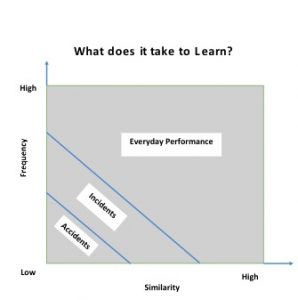How would you like to discover what’s really going on in your organisation?
Policies, procedures and processes – what we call ‘work as imagined’ are sensible things to have. But if they don’t correlate with what your people really need to get through their shift (what we call ‘work as done’), then you end up with a dangerous gap between what you believe is happening and what actually happens day-to-day.
Into this gap fall priorities like production, quality, health, safety and welfare – competing, and creating fertile ground for miscommunication, which eventually manifests as accidents and avoidable harm.
Yet the solution, or at least part of it, could be as simple as speaking to your staff in a non-confrontational, non-judgemental way on a regular structured basis.
Every improvement should begin with a conversation, not an incident
Why wait until something has gone wrong or blood has been spilt, you might say? When a straightforward conversation about how someone’s day is going can avoid all that pain and suffering.

Taking time like this for a quick chat not only builds trusting relationships, it opens windows on your world where you can identify those gaps between documentation and reality on the front-line.
You’ll also understand why things go well the vast majority of the time. Is it your superb policies and procedures? Or ingenious team members using hands-on rationality to balance efficiency and thoroughness? Chances are it’s the latter, as illustrated in the diagram.
You’ll also identify problems and discuss solutions quicker, with those best placed to fix them, as well as implement and own them thereafter. Opportunities abound in seemingly humdrum everyday activity:

A conversation offers much more than all this though. It is a gateway to understanding a range of human factors affecting how people behave and perform. For example, the influence of third-parties; individual issues; team and task factors; environmental issues; management and organisational issues such as the culture within teams, departments and sites.
Conversations are a simple yet enlightening way to propel your safety culture on its journey towards greater maturity. With a little guidance from our experts at Tribe, plenty of practice and a helpful framework to work within, you too can shift attitudes from a safety I type agenda, to a far more desirable safety II type culture.
| Safety I | Safety II | |
|---|---|---|
| Definition of safety | As few things as possible go wrong | As many things as possible go right |
| Safety management principle | Reactive respond when something happens, or categorise as unacceptable risk | Proactively, continuously trying to anticipate developments and events |
| Explanations of accidents | Accidents are caused by failures and malfunctions. The purpose of an investigation is to identify contributory factors | Things basically happen in the same way, regardless of the outcome. The purpose of an investigation is to understand how things usually go right as a basis for explaining how things occasionally go wrong. |
| Attitude to the human factor | Humans are predominantly seen as a liability or a hazard. | Humans are seen as a resource necessary for system flexibility and resilience |
| Role of performance variability | Harmful, should be prevented as far as possible. | Inevitable but also useful. Should be monitored and managed. |
- Figure One – The Normal Focus for Safety 1:10000 failure, ignoring the underatsnding of why work goes well 9999:10000 – Ref – Eric Hollnagel
- Figure Two – Opportunities for Learning are in everyday relevant activity – Ref- Eric Hollnagel
- Figure Four – Ref Eric Hollnagel, Hollnagel E. Safety I&II The Past and Future of Safety Management. Ashgate, 2014
About Colin Hewson
Lead Consultant
Colin has spent more than 20 years in senior roles within local government and leisure; and will soon be celebrating 20 years as a culture change consultant. Colin is always reading and learning and is influenced by the work of Sydney Dekker, Erik Hollnagel and the Safety Differently movement.
Specialisms: Human Factors, Just and Fair/Restorative Culture, Leadership and employee engagement.
Industry experience: Aviation Engineering, Defence, Leisure, Manufacturing, NHS, Utilities



